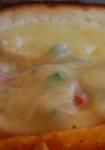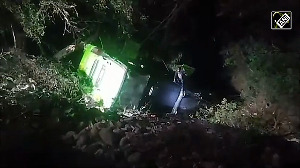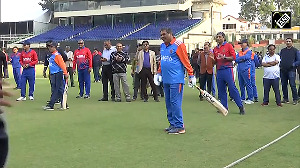Though players like the Bharatiya Janata Party and Lok Satta Party of bureaucrat-turned-politician N Jayaprakash Narayan are also in the fray for the May 16 Lok Sabha and assembly elections, analysts say their impact is not likely to be significant and the main fight will be essentially among Congress, the Grand Alliance and the PRP.
While the Congress is readying itself to fight the elections on the 'development-welfare', the Grand Alliance has a host of issues ranging from corruption to Telangana.
On the other hand, Chiranjeevi is harping on 'change'. Andhra Pradesh could well decide who would form the next government in New Delhi, according to the analysts.
By sending as many as 33 members to the Lok Sabha in 2004, the Andhra Pradesh electorate helped Congress form a government at the Centre in the company of other political party in a big way.
But the Grand Alliance, claiming itself as the 'third alternative', is bent on spoiling the chances of the ruling Congress by "exposing its failures".
Equally bent is PRP, which might well give a tough fight to both the Congress and the GA by splitting their votes in most pockets in the state.
But PRP's aspirations may actually come a cropper if it fails to secure a common symbol for all its candidates. As things stand, the party that is solely banking on the charisma of megastar Chiranjeevi is unlikely to get a common symbol.
Another most significant aspect of this elections will be the total isolation of the ruling Congress in the state. In 2004, the Left parties had aligned with the Congress while the TRS was also part of the alliance that ousted N Chandrababu Naidu from power.
TDP had only BJP for company in 2004 but the combination could not outwit the Congress-Left-TRS combine. Congress, however, is putting up a brave front saying no combination or force can prevent it from retaining power.
"It will be a positive vote for the government, which is quite unprecedented. The slew of welfare measures, apart from the major development works including the construction of irrigation projects, will stand us in good stead," Chief Minister Y S Rajasekhara Reddy said.
The 2004 poll outcome also makes for an interesting study. The Congress, which polled 38.56 per cent of the total valid votes, bagged 185 seats in the 294-member state assembly while the TDP with a 37.59 per cent vote share could muster only 47 seats.
The CPI got 1.53 per cent votes (six seats), the CPI-M 1.84 per cent (nine seats) and the TRS 6.68 per cent (26 seats) while the BJP secured 2.63 per cent and just two seats.
On the other hand, Congress won 33 seats, TDP four, TRS two, while CPI, CPM and MIM bagged one Lok Sabha seat each.
But this year, things are likely to be different. CPI-M, CPI and TRS have now crossed over to TDP with the sole objective of dislodging the Congress. BJP has none for company this time and is striving to rediscover itself in the state.
And this is where analysts say that PRP might come into play in splitting votes, particularly in the coastal Andhra region and to some extent in Rayalaseema.
PRP's impact is expected to be the maximum in the East and West Godavari districts, which hitherto used to be TDP's citadels.
In north coastal Andhra too -- comprising Srikakulam, Vizianagaram and Visakhapatnam districts -- Chiranjeevi's party is likely to eat into the traditional TDP votes much to the comfort of Congress.
In the final analysis, this could prove to be the most decisive factor in determining who comes to power. Of course, the outcome in Telangana will also be crucial as the region has as many as 117 seats.






 © 2025
© 2025